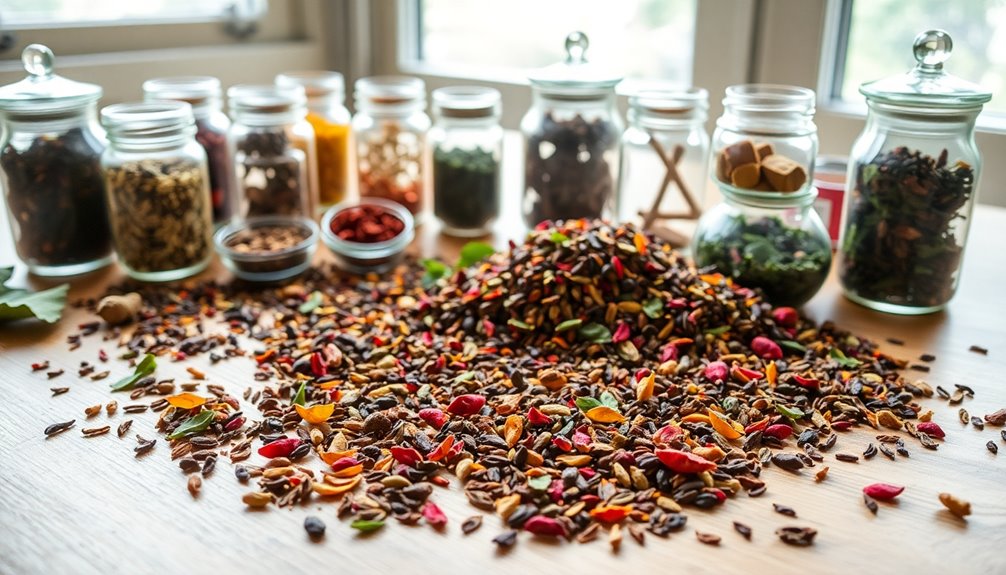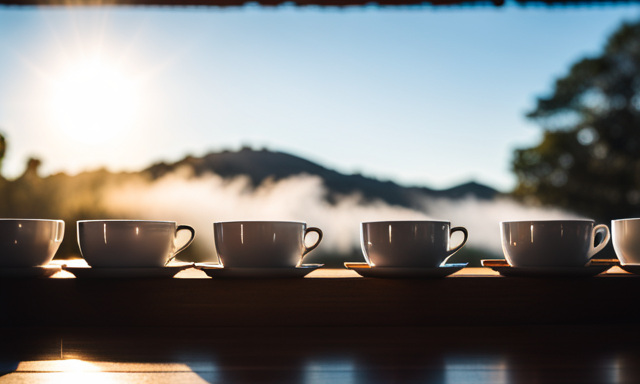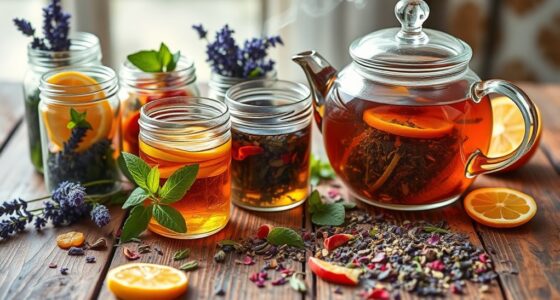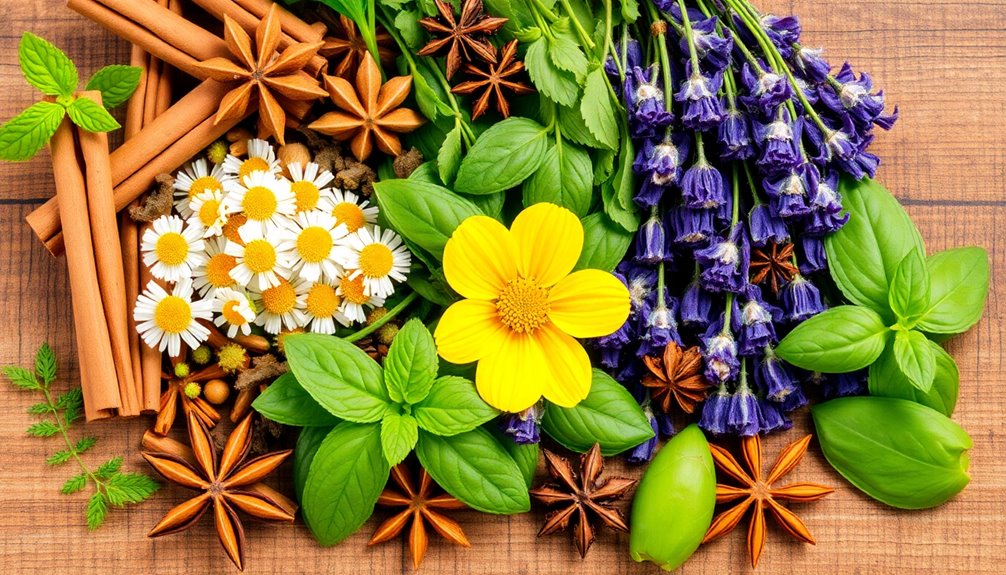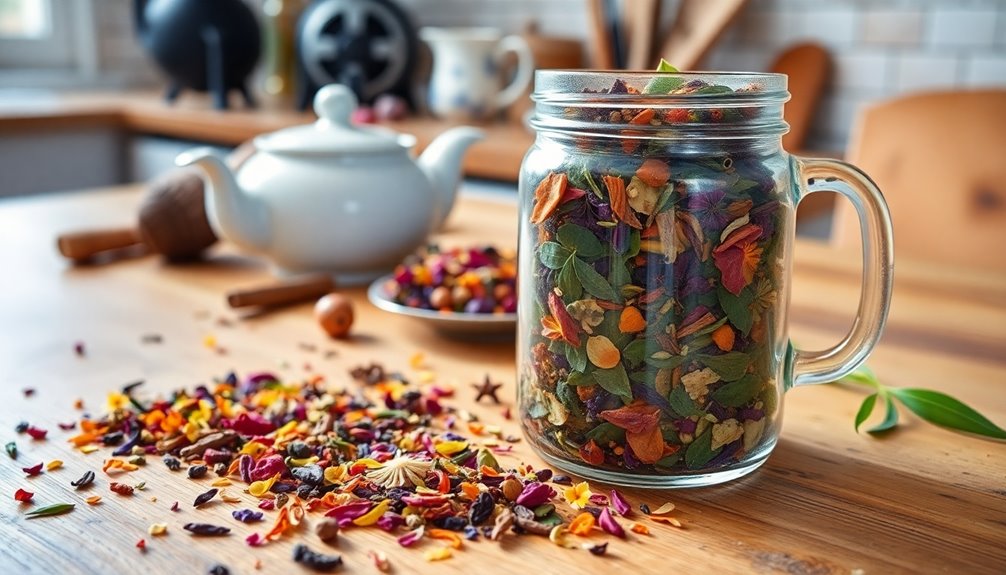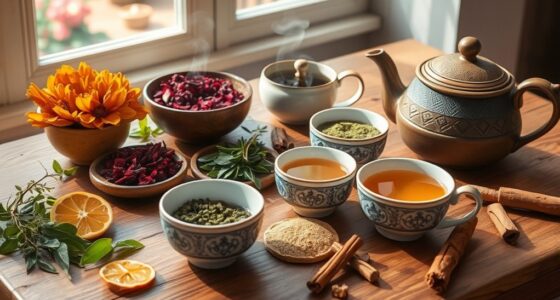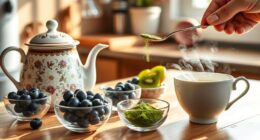Balancing flavors in tea blends is a joyful journey, and you can create delightful mixtures with just a few tips! Start with a strong base tea, like robust black tea, then add 40% flavoring elements for a delicious aroma. Mix in spices or fruits to bring your blend to life, and don't forget aromatic touches, like jasmine or cinnamon! Remember, complementary ingredients work best together. Be adventurous with unexpected pairings, like tropical fruits or savory herbs! With a little experimentation and creativity, you can find that perfect blend. There's so much more fun to explore, so keep discovering!
Key Takeaways
- Start with a robust base tea that provides a strong foundation for the blend's flavor profile.
- Aim for a balance of 60% base tea and 40% flavoring elements to enhance aroma without overpowering.
- Experiment with complementary ingredients that enhance each other's flavors for a harmonious taste experience.
- Incorporate aromatic touches like flowers or spices to highlight and elevate the tea's tasting notes.
- Adjust ingredient ratios through experimentation to discover the perfect mix for flavor harmony in your blends.
Introduction
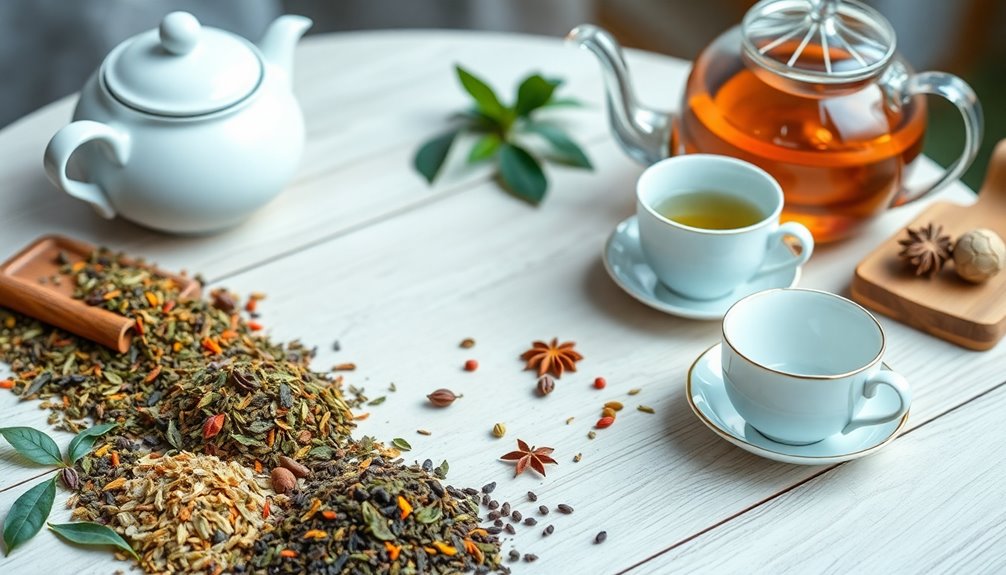
When it comes to creating the perfect tea blend, understanding the unique characteristics of each ingredient is key.
You'll discover that tea blending is an art! Start with your base tea, like robust black teas, which have their own astringency and flavor. These elements shine through when paired with the right flavoring elements.
To achieve harmony in your blend, balance is crucial. A great rule of thumb is to use about 60% base tea and 40% flavoring elements.
This way, you'll enhance the tea's aroma and flavor without overpowering it. You can add aromatic touches like jasmine flowers or cinnamon to create a delightful experience.
Flavor Profiles in Tea Blends

Creating unique flavor profiles in tea blends involves a careful balance of base teas and complementary ingredients. You can start with a strong black tea, which often has a bold taste, and mix it with delightful fruits or spices. This combination can create a warm and inviting aroma that lifts your spirits!
Think about popular tea blends like Earl Grey or Masala Chai. Earl Grey combines black tea with bergamot oil, giving it a refreshing citrus aroma. On the other hand, Masala Chai features a mix of spices that adds a cozy feel to your cup.
Using masterful blending techniques, like scenting and flavoring, tea artisans craft these unique characteristics. They know that the chemistry of flavor pairing is key! Certain ingredients enhance each other's flavors, resulting in a more enjoyable tea experience.
Don't forget about herbal blends, which can offer a whole new world of flavor profiles! Whether you prefer sweet, spicy, or floral notes, there's a blend out there waiting for you.
Flavor Harmony Is Essential
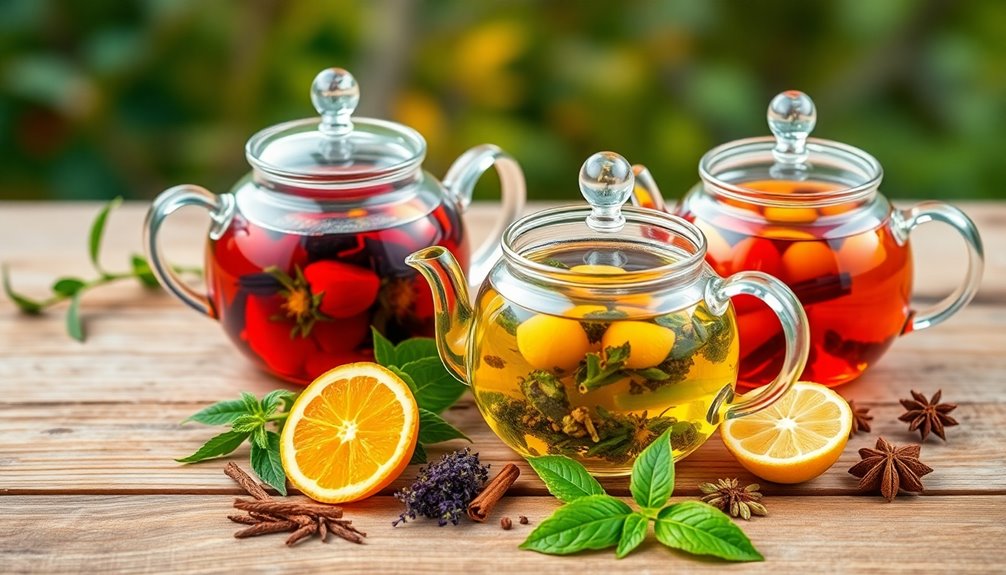
Achieving flavor harmony in tea blends is crucial for crafting a delightful experience. When you blend different ingredients, you want them to complement each other instead of competing. Think of it like creating a beautiful painting where every color shines together!
To start, focus on the balance of base teas, like black, green, or herbal. These foundational flavors set the stage for your unique tea flavors.
Next, consider adding aromatic ingredients, such as flowers or spices, that bring out those delightful tasting notes. For instance, combining floral notes with citrus can create a refreshing twist, while earthy tones paired with spices can add warmth and depth.
Experimentation is key! Try different ratios of your ingredients until you find the perfect mix. Additionally, incorporating ingredients like turmeric and ginger can enhance both flavor and health benefits in your blends.
Unexpected Ingredient Pairings
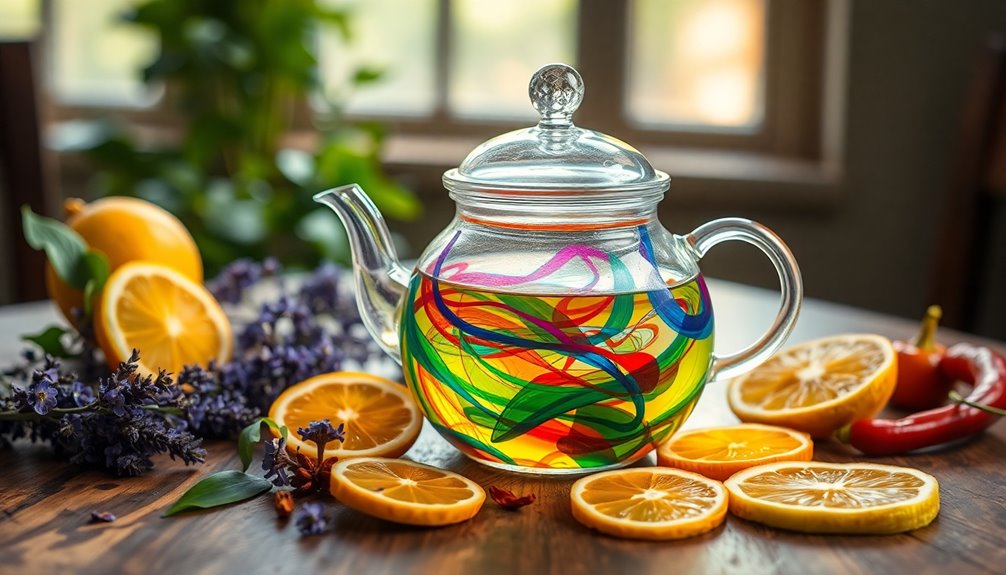
Unexpected ingredient pairings can take your tea blends to a whole new level, elevating the tasting experience. Imagine combining floral notes with earthy spices—how delightful!
These unexpected ingredient pairings can create a more layered flavor profile that surprises and delights your taste buds. Additionally, exploring these combinations can enhance your mental potential, making the process of tea blending not only creative but also a form of personal expression. Incorporating flavors that stimulate the senses can lead to more engaging and hands-on learning experiences. Furthermore, the art of blending can be compared to creating essential oil blends, where various components work together to achieve a harmonious outcome. The creativity involved in blending can be similar to the innovation seen in young tennis prodigies, showcasing how unique combinations can lead to exceptional results.
Here are some fun ideas to get you started:
- Chili or Black Pepper: Adding a pinch of these spices to herbal blends gives a surprising kick, balancing sweetness with heat.
- Fruits like Lychee or Passionfruit: Tossing these into black tea offers a refreshing contrast, brightening up those robust flavors with a tropical twist.
- Savory Herbs: Consider mixing in basil or thyme. These can bring a unique culinary experience to your tea, making every sip feel special.
- Matcha with Coconut or Cacao: This unusual combination can surprise your palate and challenge typical flavor expectations, making your tea experience even more exciting.
Additionally, experimenting with AI-driven storytelling techniques can inspire you to create unique blends that resonate with your personal taste.
Ingredient Sourcing Dilemmas
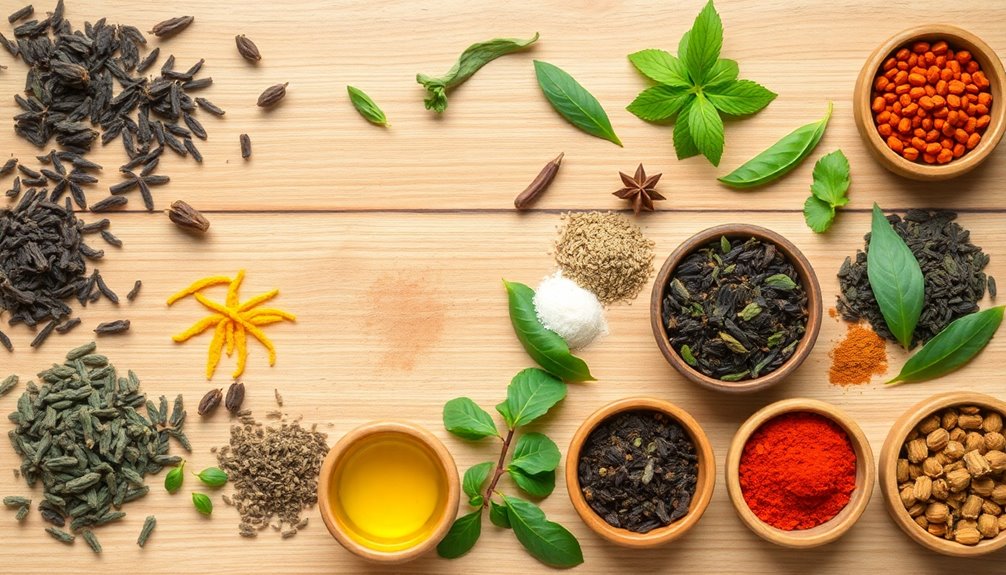
When crafting unique tea blends, sourcing high-quality ingredients can present some real challenges. You want your tea leaves and other components to shine, but that's not always easy! Regional availability plays a big role in ingredient sourcing, so some herbs might be plentiful in your area while others are harder to find. This can impact the authenticity and uniqueness of your blend.
Sustainable sourcing is also important these days. Many consumers want teas that aren't only delicious but also friendly to the environment.
Plus, seasonal variations can affect the flavor of certain ingredients, so you may need to adapt your recipes throughout the year. Here are a few tips to tackle these dilemmas:
- Connect with local farmers: They often have fresh, unique ingredients that reflect your region's tastes.
- Be flexible: Embrace the seasonal changes and adjust your blends accordingly.
- Prioritize quality: Always choose high-quality ingredients for the best flavor.
Practical Applications

Mastering the art of tea blending requires a thoughtful approach to practical applications that enhance flavor balance. Start your tea journey with a well-defined base, like black or green tea. Gradually add complementary ingredients such as herbs, spices, or fruits. This helps create that perfect balance, ensuring no single flavor overpowers another. Additionally, incorporating flower teas can introduce a range of flavors and health benefits to your blends.
Here are some tips to consider:
- Experiment with Ratios: Try different kinds of tea and tweak the amounts of each ingredient. Small changes can lead to amazing new tea flavors!
- Blind Taste Tests: Share your blends with friends and family! Their feedback can guide you toward the best combinations.
- Flavor Pairing Principles: Learn that floral notes work beautifully with fruity or spicy elements. These pairings can elevate your blend to new heights. Additionally, incorporating essential oils for relaxation can enhance the calming effects of your tea blends, creating a harmonious experience. Using specific tea types as your base can dramatically influence the final flavor profile. Furthermore, certain essential oils can stimulate the limbic system, enhancing the overall emotional experience of your tea.
- Quality Matters: Always use premium ingredients and clean, high-quality teaware. This ensures the best extraction of flavors and makes your tea experience even more enjoyable. Consider adding eucalyptus oil for its soothing properties to further enhance your tea's relaxing qualities.
Frequently Asked Questions
How to Make a More Flavorful Tea?
To make a more flavorful tea, choose a complementary base, adjust ingredient ratios, and incorporate aromatic elements. Use high-quality, fresh ingredients, and steep at the right temperature and time for the best flavor extraction.
What Teas Mix Well Together?
When mixing teas, try pairing green or white teas with herbs for a light touch. Black teas blend well with spices, while herbal teas enhance fruity notes. Just avoid combining green and black teas together.
What Is the Ratio for Tea Blending?
When blending teas, you should consider ratios like 1:1 for balance or 3:1 for stronger bases. Adjust according to your taste, and don't hesitate to experiment to find your perfect mix.
How to Make Good Flavoured Tea?
To make good flavored tea, start with a solid base, like black or green. Experiment with herbs and spices, adjusting ratios. Don't forget to scent your leaves and taste-test different blends for balance.
Conclusion
So, as you explore the world of tea blends, remember to have fun! Try mixing different flavors, and don't be afraid to experiment with unexpected ingredients. You'll discover delightful surprises that tickle your taste buds. Whether you're sipping tea with family or sharing a cozy moment with friends, balancing flavors can create the perfect brew for any occasion. Let's raise our cups to new adventures in tea blending and enjoy every sip together! Cheers!

